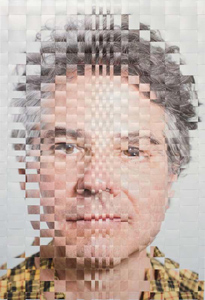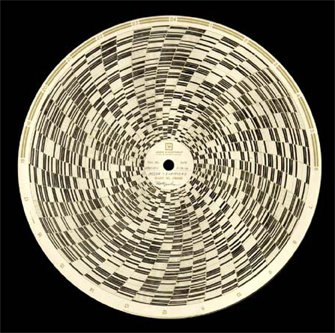 The following letter was written to me by Alec MacLeod during our residence at the Vermont Studio Center in 2011. Alec is an artist and a scholar and currently a professor at California Institute of Integral Studies.
The following letter was written to me by Alec MacLeod during our residence at the Vermont Studio Center in 2011. Alec is an artist and a scholar and currently a professor at California Institute of Integral Studies.
 Dear Heather,
Dear Heather,
This is not as coherent as I would ultimately like it to be. What I have tried to do is offer a kind of phenomenological reading of my experience of encountering your work. It is highly personal and probably says as much or more about me that it does about your work. I trust that you will take my words with a grain or more of salt.
Let me start with the obvious: the inescapable visual AND conceptual reference is a vinyl phonograph record. I see a data set presented in the round. There is a label in the center and even the illusion of a hole in the center. I can no more read the data inscribed in the paintings than I can read the analog data in the grooves of the record. Nonetheless, at first glance I feel confident that it is there if only I have the proper tools for extraction.
The circular plot, the numbers around the circumference, the central label, all lend an air of scientific authority to the image. I want to believe that as with any scientific figure or plot that there are those for whom this is THE most efficient way to display the information, that I am just not that audience. So initially, I marvel that there are those who can read this.
 Or are there? Closer inspection reveals that this is a painting of a diagram, not the precise plot a computer generates. The hand of the artist is evident. I know I told you that I was not likely to provide too many art historical references, but I cannot help but see an echo of those early elegant black paintings of Frank Stella’s which had that same sense of being simultaneously precise and painterly. The obvious difference is that he was trying to rid the work of meaning while you are trying to infuse it with meaning.
Or are there? Closer inspection reveals that this is a painting of a diagram, not the precise plot a computer generates. The hand of the artist is evident. I know I told you that I was not likely to provide too many art historical references, but I cannot help but see an echo of those early elegant black paintings of Frank Stella’s which had that same sense of being simultaneously precise and painterly. The obvious difference is that he was trying to rid the work of meaning while you are trying to infuse it with meaning.
As a painting, yours is no dry diagram; it is one step removed from that. As a result a series of questions raise themselves in my mind. Is the data readable or not? What was lost in this translation? Is this data, information, or knowledge? What I finally conclude is that you have taken knowledge and reduced it, through multiple reasonable and logical processes, to data. It’s beautiful data, but meaning is indecipherable to the viewer who must be told what is encoded. Nor does it seem that scientific accuracy was gained in the process of translation. What initially seemed authoritative and precise now seems less decipherable, even to the trained specialist.
So what are you doing? Each step of the process of transformation and representation has a reason. The outcome is precise (although there is, no doubt, a certain amount of error that creeps in). But you cannot “play” this record. The only way I can see to recover meaning is to work backwards, to decode the encoding. There is no forward process that could be applied to this representation, no next step that would reconstitute the original text or audio. Instead the information is a hidden message. Indeed I think you love the fact that the meaning is hidden. I may be able to look at the final product and know, with a great deal of certainty that you have precisely translated your information with accuracy, but I have to take your word for it that the information you say is encoded is indeed present.
I want to make clear that I am not suggesting that you might be tricking the viewer. I am positive that the paintings would be entirely different if you just drew out the graph and filled in the cells willy-nilly. I feel that I would somehow know the difference between the “authentic” representations and random choices. Even more, I feel confident that you could tell the difference.
I am told that the relationship between mathematical models and the material world is one we take on faith, though a faith that is buttressed by the apparent success of these representations. But ultimately, proof lives only in the universe of numbers. In the rest of existence, we must take proof on faith. I find myself feeling that you have a deep desire for certainty and precision in a world in which information is ultimately incomplete and open to multiple interpretations. You want a reason for everything, when reasons are elusive. Yours is a valiant but ultimately doomed effort to give reason to your work. And a noble effort it is; and it is one that deserves to be respected and appreciated. When I step back, the part of the process that is not subject to reason becomes the most important: the selection of what to encode. The paintings are beautiful in their own right. And the encoding of the messages is a form of magic.
Thanks for letting me write to you about this. I hope you feel okay about what I have said.